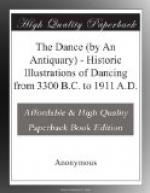“Malibran’s dead,
Duvernay’s fled;
Taglioni has not yet
arrived in her stead.”
[Illustration: Fig. 65.—Pas de Trois by Mlles. Ferraris, Taglioni, and Carlotta Grisi.]
Mlle. Duvernay was a Parisian, and commenced her study under Barrez, but subsequently was under Vestris and Taglioni, the father of the celebrity mentioned in the verse.
[Illustration: Fig. 66.—Mlle. Adeline Genee, 1906. Photo, Ellis and Walery.]
Duran hangs over the mantelpiece of the refectory of the presbytery.
[Illustration: Fig. 67.—Mlle. Anna Pavlova, 1910. From a photo by Foulsham and Banfield.]
Having made a great Parisian reputation, she came to London in 1833, and from that date until 1837 held the town, when she married Mr. Stephens Lyne Stephens, M.P., a gentleman of considerable wealth, but was left a childless widow in 1861, and retired to her estate at Lyneford Hall, Norfolk, living in retirement and spending her time in good works. She is said to have spent L100,000 in charities and churches, and that at Cambridge, dedicated to the English martyrs, was founded, completed, and endowed by her. She led a blameless and worthy life, and died in 1894. Her portrait by Mlle. Taglioni (fig. 64), her co-celebrity, married Count Gilbert de Voisins, a French nobleman, in 1847, and with her marriage came an ample fortune; unfortunately the bulk of this fortune was lost in the Franco-German war. With the courage of her character the Countess returned to London and gave lessons in dancing, etc., in which she was sufficiently successful to obtain a fair living. She died in 1884 at 80 years of age. Of the other celebrities of the period—Carlotta Grisi, Ferraris (fig. 65), and Fanny Ellsler (fig. 63)—some illustrations are given; besides these were Fanny Cerito, Lucile Grahn, a Dane, and some others of lesser notoriety performing in London at this great period of the ballet.
[Illustration: Fig. 68.—Mlle. Sophie Fedorova.]
The recent encouragement of the classic ballet has introduced us to some exquisite dancers: amongst these are Mlle. Adeline Genee (fig. 66) and Mlle. Anna Pavlova (fig. 67); the latter, with M. Mordkin and a corps of splendid dancers, are from Russia, from whence also comes the important troupe now at the Alhambra with Mlle. Geltzer and other excellent dancers. The celebrated company at Covent Garden, and Lydia Kyasht at the Empire, are also Russian. It is not surprising that we get excellent dancing from Russia; the school formed by Peter the Great about 1698 has been under State patronage ever since.
Notices of all the important dancers from Italy, Spain, Paris, or elsewhere, performing in England in recent years, would occupy considerable space, and the reader can easily obtain information concerning them elsewhere.
That the technique and speed of the classic dance has considerably increased is historically certain, and we must hope that this speed will not sacrifice graceful movement. Moreover, technique alone will not make the complete fine-artist: some invention is involved. Unfortunately, some modern attempts at invention seem crude and sensational, whilst lacking the exquisite technique desirable in all exhibitions of finished art.




